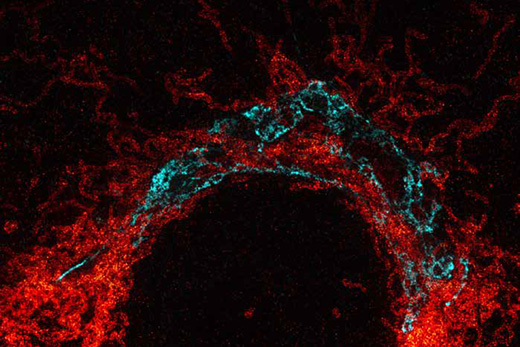Neil Anthony, PhD, director of the Emory Integrated Cellular Imaging (ICI) Core, has been awarded a $1 million High-End Instrumentation Grant (S10OD028673) from the National Institutes of Health to purchase a powerful new research microscope.
Once installed, the Abberior Facility Line easy 3D STimulated Emission Depletion (STED) fluorescence microscope will be the first of its kind in the state of Georgia. This adjustable, super resolution system performs four-color, live-cell 3D imaging at the nanoscale in real time. The STED microscope was selected following a multi-week, hands-on evaluation and feedback from users on both the Leica STED-3X and the Abberior easy3D STED.
"Bringing cutting-edge techniques and equipment to researchers is central to ICI's mission," says Anthony. "Abberior's latest iteration of STED microscopy is truly a next-generation tool, and we are excited to support investigators with technology that will allow them to ask and answer important new research questions."
ICI is jointly managed by Winship Cancer Institute and the Emory University School of Medicine and is part of the Emory Integrated Core Facilities. With four locations and 18 microscopes, ICI offers an array of high-caliber, light-based microscopes across the Emory campus and is one of the largest imaging core facilities in the Southeast.
"This game-changing super resolution system offers a window into a variety of human diseases, from cancer to infectious diseases," says Adam Marcus, PhD, Winship associate director for basic research and shared resources, who also serves as ICI's scientific director. "When we can visualize molecular-level interactions with such a degree of precision, it becomes more feasible to develop strategies for cancer prevention and treatment."
Every instrument awarded by an S10 grant is used on a shared basis, which makes them cost-efficient and able to maximize the benefit to investigators. Not only will Emory benefit from access to the STED microscope, the system will also be available at a subsidized rate to researchers from all eight institutions within the Georgia Core Facilities Partnership: Augusta University, Clark Atlanta University, Georgia Institute of Technology, Emory University, Georgia State University, Mercer University, Morehouse School of Medicine, and the University of Georgia.
"The impact of this new technology will reach beyond the Emory campus to our Georgia Core Facilities Partnership institutions," says Michael E. Zwick, PhD, who leads the Emory Integrated Core Facilities and is a founding member of the Georgia Core Facilities Partnership. "The spirit of this partnership is to help ensure all Georgia researchers have access to the tools of innovation. We are extremely proud that ICI could bring such a significant new resource to support scientific advances in our state."

